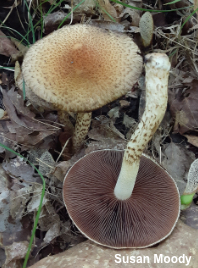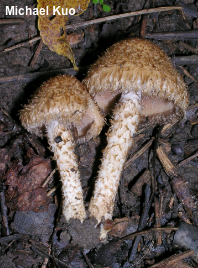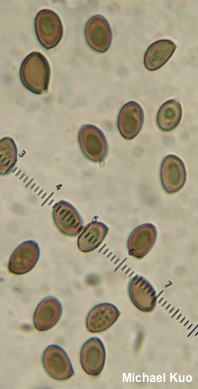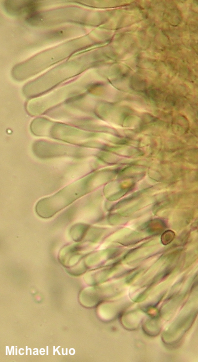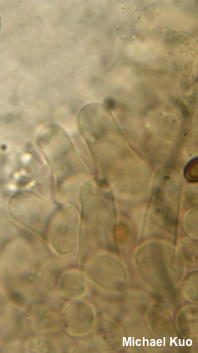| Major Groups > Gilled Mushrooms > Dark-Spored > Lacrymaria echiniceps |

|
Lacrymaria echiniceps [ Basidiomycota > Agaricales > Psathyrellaceae > Lacrymaria . . . ] by Michael Kuo Lacrymaria echiniceps is a woodland species found in the United States from the Great Plains eastward, featuring a cap and stem covered with brown scales and fibrils. The gills are attached to the stem, and become brown—almost purplish brown—with maturity; their edges are whitish and contrasting as a result of abundant microscopic cheilocystidia forming a sterile zone. Similar mushrooms include Lacrymaria velutina, which is more likely to be found in grassy places than in woods and features a bald stem and larger spores—and various brown-spored species from Pholiota, Inocybe, and elsewhere; microscopic examination may be required to identify Lacrymaria echiniceps with confidence. I would love to see a tiny "button" of this species some day, since it must be fuzzy, brown, and super cute; the scales and fibrils on the cap and stem of developing specimens result from a form of universal veil—a protective covering that covers the young mushroom and gets stretched out with development. Psathyrella echiniceps is a former name. Thanks to Susan Moody for collecting, documenting, and preserving Lacrymaria echiniceps for study; her collection is deposited in The Herbarium of Michael Kuo. Description: Ecology: Saprobic; growing on the ground alone, gregariously, or in groups in hardwood or conifer forests; summer through fall; originally described from New York; fairly widely distributed in the northeastern, mid-Atlantic, and Midwestern United States and adjacent Canada. The illustrated and described collections are from Illinois and Minnesota. Cap: 3–6 cm; convex to bell shaped, becoming broadly convex, broadly bell-shaped, or nearly flat; dry; dull yellowish to dull brownish orangish under medium brown, fibrillose scales. Gills: Broadly attached to the stem; close; short-gills frequent; pale brownish at first, becoming medium brown with a hint of purple; with whitish, contrasting edges; faces mottled at maturity. Stem: 4–7 cm long; 6–10 mm thick; equal; whitish and mealy at the apex, but elsewhere whitish underneath brown fibrils and scales; basal mycelium white. Flesh: Whitish to watery brownish; unchanging when sliced. Odor: Not distinctive. Spore Print: Dark purplish brown. Microscopic Features: Spores 7–9 x 4–5 µm; ellipsoid to subamygdaliform, with a small pore; smooth; brown in KOH. Basidia 18–20 x 5–6 µm; abruptly clavate; 4-sterigmate. Cheilocystidia abundant, in a sterile zone; 55–75 x 5–7.5 µm; cylindric-flexuous, with clavate to subclavate or subcapitate apices; smooth; thin-walled; hyaline in KOH. Pleurocystidia 30–40 x 7.5–10 µm; more or less utriform; smooth; thin-walled; hyaline; scattered; sometimes grouped in twos or threes. Pileipellis a hymeniform layer of yellowish pyriform elements 20–50 µm wide, from which arise bundles of cylindric, brown, clamped elements 5–12.5 µm wide, with smooth or encrusted walls. REFERENCES: (G. F. Atkinson, 1909) P. Voto, 2019. (Murrill, 1922; Smith, 1972; Smith, Smith & Weber, 1979; McNeil, 2006; Padamsee et al., 2008; Sturgeon, 2018.) Herb. Kuo 08202004. This site contains no information about the edibility or toxicity of mushrooms. |
© MushroomExpert.Com |
|
Cite this page as: Kuo, M. (2020, December). Lacrymaria echiniceps. Retrieved from the MushroomExpert.Com Web site: http://www.mushroomexpert.com/lacrymaria_echiniceps.html |
